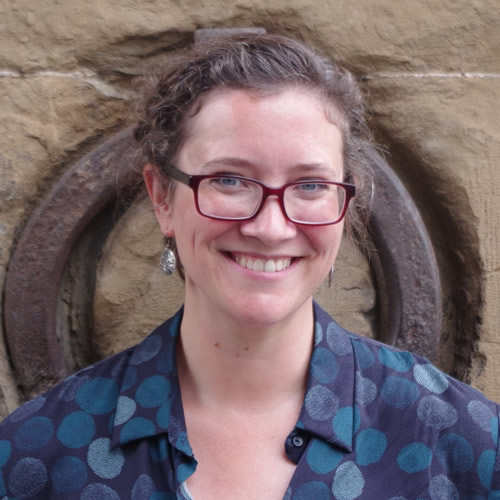 Erin Giffin
Erin Giffin
visiting assistant professor of Art History
CONTACT INFORMATION
Office: Filene #102
Phone: 518-580-5047
Email: egiffin@skidmore.edu
Spring 2024 Office Hours:
Tuesdays, 12:30 pm-1:30 pm
Wednesdays, 12:30 pm-1:30 pm
EDUCATION
- PhD, University of Washington, Seattle, WA, 2017
- MA, University of Washington, Seattle, WA, 2012
- BA, Smith College, Northampton, MA, 2008
REGIONAL FOCUS
Early Modern European and Colonial Art History, with a focus on international connections of Italian communities
RESEARCH AND TEACHING INTERESTS
As a specialist of Global Early Modern art history, Erin Giffin’s research explores cross-cultural relations through artwork production, particularly focusing on the sculpture, architecture, and ephemera that respond to religious practices and express popular devotion. Her classes explore questions of information dissemination and copying across early modern Catholic communities, as well as confrontations of faith and commerce in missionary contexts (specifically in East Asia, and North and South America). Erin’s classes investigate expressions of identity politics through personal and family monuments; prints and other circulating media like ambassadorial gifts; and immersive religious spaces such as the Sacri Monti. Her first monograph, currently entitled Translating Space: Replicas of the Holy House of Loreto, investigates replicas of the purported Holy House of the Virgin Mary at Loreto, Italy, which was recreated extensively across the Catholic world. Prior to teaching at Skidmore, Erin was the Robert Lehman Fellow at I Tatti, the Harvard University Center for Italian Renaissance Studies in Florence, Italy (2021-2022), and a postdoctoral fellow in the research group SACRIMA: The Normativity of Sacred Images in Early Modern Europe, based at Ludwig-Maximilians-Universität in Munich, Germany (2017-2021). Beyond Early Modern European studies, Erin also pursues research interests in Japanese and Native American art history, particularly the history of hidden Christian (Kakure Kirishitan) communities, and modern indigenous art of the Pacific Northwest Coast and Pacific Islands.
COURSES
- AH 151D: Expanding Horizons: Pictures, Objects, and Spaces in Early Modern Europe
- AH 351C: Art, Power, and Identity Politics in Early Modern Europe
SELECT PUBLICATIONS
- “Pietro Paolo Drei’s Flower Mosaics Revealed in Print,” Print Quarterly, Vol. 38, No. 1 (2021): 17-29.
- “The Tradition of Change in Copies of the Santa Casa di Loreto: The Case of San Clemente in Venice,” in Sacred Images and Normativity: Contested Forms in Early Modern Art, edited by C. Franceschini, pp. 188-203 (Turnhout: Brepols, 2021).
- “Giovanni Battista Braccelli’s Etched Devotions before the Vatican Bronze Saint Peter,” I Tatti Studies in the Italian Renaissance, journal of Harvard University Center Villa i Tatti, Vol. 23, No. 2 (2020): 341-374.
- “Conflicting Sources for 3D Replicas: Adam Philippon’s Santa Casa of Loreto” online article published on the Thinking 3D Forum website, a research initiative between the University of St Andrews, Magdalen College, and the Bodleian Libraries, Oxford (published 20 July 2019 at: https://www.thinking3d.ac.uk/SantaCasaofLoreto/).
Publications in Progress
- (Forthcoming) “What’s in a Replica? The Unfixed Iconography of Sixteenth-century Simulacra of the Santa Casa di Loreto,” in Sacri Monti and Beyond: Holy Land Simulacra and Monumental Stational Programs across Europe, c. 1400-1600, edited by P. Stewart and A. Timmermann (Turnhout: Brepols, 2023).
- (Forthcoming) “Retracing the Frame: Frescoed External Revetment of Santa Casa Replicas across the Czech Republic,” in Madonne. Reframing Images of Mary in Early Modern Spaces, edited by C. Franceschini and E. Giffin (Turnhout: Brepols, 2023).
- (Forthcoming) “Exceeding Expectations: Antonio Begarelli, his Female Patrons, and the Misunderstood Materialities of White Terracotta,” in Modelled, Fired, Transformed: Materiality of Terracotta Sculpture 1400-1600, edited by Z. Sarnecka (London: Routledge, 2022).